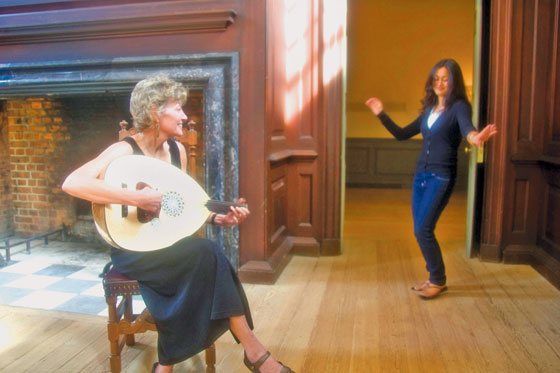Key to a culture
Middle Eastern Music Ensemble opens the door to greater understanding
Music serves as a lens through which the West can view Middle Eastern culture.
“It is an excellent way to investigate important aspects of culture—from history to colonialism and from contemporary politics to social constructs, like gender,” says Anne Rasmussen.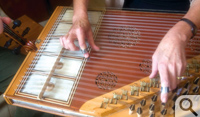
Music can also provide a means of passing down important information about cultural traditions, events and contemporary news—information eventually recorded by historians.
To serve both ends, Rasmussen, professor of music and ethnomusicology at William and Mary, not only teaches classes such as Worlds of Music, but also directs the College’s Middle Eastern Music Ensemble, a scholarly labor of love that she began in 1994.
The ensemble is as much a cultural laboratory as it is a performing collaborative. Membership has waxed and waned over the group’s 28-semester life and usually mixes students from the Middle East (or who have parents or grandparents from the Middle East) with other students from a variety of different backgrounds, who are interested in the idiom for any number of reasons.
What does it mean to teach something that is outside the Western musical canon? Especially something that comes from a culture and place we know so little about?
“When we hear music from other cultures, we have not been drilled with the history of that area. We have not heard that music in advertising jingles and film scores; we have no method by which to place it, no context for understanding it,” place it,” Rasmussen said. By contrast, we are immersed in the context of Western culture and its music. “For example, you might have a flute student studying works of a Western European classical composer. That student can walk out of a lesson and go to a concert and hear music by that same composer. Or they will see a film where they hear flutes in the soundtrack. Then our same student goes to a history class and learns about nationalism or the Romantic or Classical periods, which enables them to put their flute piece into a historical context.”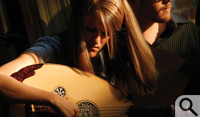
So musical traditions become cultural markers, evidence that someone or something belongs to a social or ethnic group. Each culture has musical systems intertwined in its own unique history, as a composition for flute is not just a musical piece, but also a contextual piece of the history and culture of, say, Vienna in 1750.
If 18th-Century Vienna seems ancient, Rasmussen points out that the culture of the Middle East contains traditions of literate music theory dating back to the 8th and 9th centuries, within which people were already writing and taking examples from the Greeks about the role of music.
“Early scholars believed that music, arithmetic, geometry and astronomy—the Quadrivium—represented paths of knowledge which were fundamentally interconnected,” says Rasmussen.
“They wrote about the role of various instruments, how harmonics work, the morphology of instruments and the way strings vibrate, but they also studied the way that music affects the human body and the cosmos.”
Into the music
Drawing on such a rich cultural background, the participants in William & Mary’s Middle Eastern Music Ensemble learn the intricacies of rhythm and the arcana of instrumentation—but the heart of the enterprise is making the music. Rasmussen says the ensemble provides a forum for students to do the “real stuff” beyond reading articles, writing papers and watching films.
“Some of these kids often come to the group with excellent musicianship, but no prior experience with the Arab, Turkish, Persian, Armenian and Greek traditions that comprise the music of the Middle East,” Rasmussen said. “They might be alternative musicians who play the mandolin, or singer-songwriters or just really creative musicians. Or they might be ‘heritage learners’—students of global studies and international studies whose parents or grandparents are from Bangladesh or Saudi, for instance. We are a very diverse group.”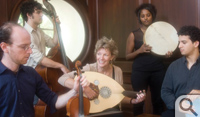
Each incarnation of the ensemble presents Rasmussen with a different version of the pragmatic challenge of figuring out who should play what. Most ensemble members are already experienced musicians, which gives her a starting point. For instance, she generally encourages players of wind instruments to try the nay, or flute, while she steers mandolin players and guitarists toward the ’ud , the round-backed lute. “They already have the fingering and picking motions down,” she says.
Violin players stay on violin, but use Middle Eastern tunings. Members with little or no musical background start off in percussion; Rasmussen says she likes to have at least one “real” percussionist to anchor the section.
“The only way to do an ensemble like this with limited resources of teaching and time is to attract capable musicians who already play music. If they don’t play any instruments and don’t sing, it is difficult to just wave a wand and work miracles,” she said. “If they are interested and have a decent ear and a great attitude they can learn. Sometimes a weaker musician will have a fantastic energy and that is worth all the fancy playing in the world.”
To teach the material, Rasmussen prepares a CD of the tunes, holds regular rehearsals and sometimes meets with the performers in sectionals. Musicians start off with simple ditties such as “Ah Ya Zayn,” the “Twinkle, Twinkle” of Arab music, but soon move on to more sophisticated material.
Inviting guest artists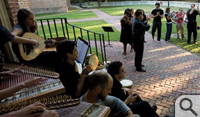
Often, Rasmussen will invite guest artists—scholars or composers or both—to lecture or perform or assist in a class. In spring 2007, the ensemble’s work focused on the traditional music of Iraq. Rasmussen arranged for the group to work with Amir ElSaffar, an Iraqi-American who has devoted his career to salvaging Iraqi music during a time of extreme unrest. ElSaffar visited William and Mary twice and performed as a guest artist in a concert of Iraqi music.
Whether there's a guest artist or not, ensemble performances are often packed.
“The quest for global knowledge in general is huge on this campus,” says Rasmussen. “For one thing, global awareness is a new prerequisite for employment, whether it’s in the government, military or public sector. Another motivating factor may be that in this particular moment of world history, students want to be able to generally be conversant in a variety of cultural contexts. Consider that many of our students were 11 years old when 9/11 happened. These kids have come of age in an era when you can’t take a tube of toothpaste on a plane because of the nation’s overarching concern for national security! I think they want to move beyond that mindset.”
A year ago, the ensemble presented a major concert in Washington, D.C., sponsored by the Embassy of Spain,with the theme “Andalusia: Cultural Crossroads.” The concert featured repertoire shared by Christians, Jews and Muslims, along with several traditional Sephardic pieces sung by guest vocalist, cantor Ramon Tasat.
“One thing we do in this kind of music is work through oral tradition,” says Rasmussen. “That is, through listening to an idiom and deciding where do you put the trills, where do you slide between notes, how can you take this melody and play with it and make it your own?”
Middle Eastern music is structured around a system of melodic modes called maqam, many of which feature quarter tones, and around rhythmic patterns called iqa‘. More complex than Western scales, the maqam have notes that fall between the notes on a piano. Rasmussen explained that the rhythmic patterns may be performed in very basic ways or may exhibit extreme complexity as well—a number of them would be considered “uneven” in Western terms.
“Stretching all the way across North Africa because of various migrations, it’s a huge kind of template for organizing melody and rhythm,” says Rasmussen. “Within each separate area, there are different names for the melodic and rhythmic modes as well as for musical instruments.”
Rasmussen’s primary area of teaching, Middle Eastern music and culture, stems from her dissertation work and some 10 years of field work among Arab American communities and Middle Eastern American communities. In addition to her work on music in the Arab world and Middle East, she is currently at work on a book. To be titled Women’s Voices, the Recited Qur’ân, and Islamic Musical Arts in Indonesia, it is based on several years of ethnographic research she conducted in Indonesia, the world’s most populous Muslim country.
Real-life, real world
A scholar of not only Islamic musical arts in Indonesia, but also of female reciters of the Qur’ân, Rasmussen asks culturally important questions: “What do the women do? What do they  look like? What does their music sound like?” What is their motivation for becoming religious specialists and professional reciters of the Qur’ân?” Her experiences and studies allow her to add flavor and diversity to her work with students and ensemble members—to debunk myths and give students examples that are not only “real-life,” but also “real-world” which, Rasmussen says, “might not always be what we get from the popular press.”
look like? What does their music sound like?” What is their motivation for becoming religious specialists and professional reciters of the Qur’ân?” Her experiences and studies allow her to add flavor and diversity to her work with students and ensemble members—to debunk myths and give students examples that are not only “real-life,” but also “real-world” which, Rasmussen says, “might not always be what we get from the popular press.”
“You can visit the most populous Muslim country,” says Rasmussen, “and you will find that these women are beautiful, articulate, very educated and quite public. You will see them on television performing a wide variety of different kinds of music or reciting the Qur’ân, an artistic and religious phenomenon central to national and cultural identity in Indonesia, as it is in the Middle East and Muslim world.
“Because it is meant to be recited aloud rather than read silently, the Qur’ân is enjoyed as a kind of musical oratory. While the meaning of the Qur’ân is central to Islam, the divine origin and power of the sound of the Qur’ân is something experienced on a purely aesthetic level, particularly in a society where few understand the Arabic language.”
Power of music
Rasmussen explains that some Islamic cultures have developed a reputation for being ‘anti-music.’ She said skepticism regarding musical performance and performers stems from the belief that music is extremely powerful and has a direct affect on human emotions and behavior.
“In Sufism, a mystical tradition of Islam, music is used as a catalyst for spiritual experience because it is so powerful and can lead you into altered states of consciousness,” says Rasmussen. “If music is used with the wrong ‘vision of the heart,’ then it can lead to crazy behaviors—like drinking, dancing and sexual promiscuity.”
The varieties of music of Islamic cultures and the Middle East are as varied as the people who make it, although they share traditions of melody and rhythm from western China all the way across central Asia and Iran and northern India. Rasmussen adds that the instruments of Western music owe a large debt to the instruments of the Middle East and the Muslim world, due to cultural exchange during the crusades and the melting pot that was created in the Iberian peninsula prior to the Spanish Inquisition.
“When you look at musical instruments themselves,” says Rasmussen, “much depends on the cultural geography. In the Middle East, instruments are small and transportable because it is a desert culture. In Southeast Asia you have huge gong-type instruments, which you can’t just throw on your camel. They stay in a special place in a court or palace and musicians come to those instruments.”
Science of performance
When she came to William and Mary over a decade ago, Rasmussen was the first professor of ethnomusicology at the College. Today she teaches a variety of courses in music and ethnomusicology, the anthropological study of a culture through its music.
“In the field of ethnomusicology, in addition to learning languages and library research, we usually engage ethnomusicological field work as a kind of participant observation method. For instance, if you want to learn about somebody’s music you could brandish a microphone and say ‘tell me about your music!’ Well they might not even have a vocabulary,” she said. “But when you sit down and play, then there is all of this other kind of exchange that happens. So for us, musical performance and participation is really part of our methodology.” 















